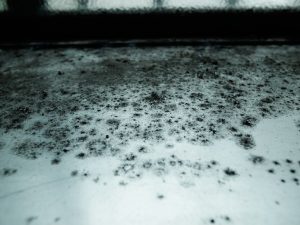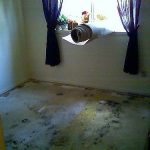Mold is a common issue for homeowners, no matter what the season. Winter, however, produces a different set of circumstances that make the contamination of mold within a home very likely. Residential homes tucked away in high-snowfall areas seemingly experience an increase in moisture during the cold season.

The heavy snow produces moisture that can lead to an infestation of mold indoors. Tightly closed windows and insulated doors during winter allow less ventilation within the space. Summer’s dry indoors transform into winter’s moisture-ridden environment. Where moisture is left unchecked, mold spores latch on and multiply.
Mold’s Destructive Path from Health to Property
Many individuals residing in colder climates remain cozy indoors during winter. Those with respiratory issues or seasonal allergies are more susceptible to mold that thrives indoors during the winter season. Being inside more often increases the likelihood of breathing in mold spores. Sensitive individuals respond with an eruption of allergic reactions, including runny nose, watery or red eyes, and skin rash.
Not only is winter mold a health risk, but spores lingering within the surfaces of indoor property cause additional damage. Insulated air ducts and other components of a heating system can get moldy if subject to dampness. Since most mold growth in these areas is inaccessible and nearly invisible to a homeowner, a specialist in mold remediation should be consulted for periodic inspection and prompt removal.
Winter days are short and the nights long, but individuals are not subject to inhaling mold all season. A bit of knowledgeable preparation before and during winter can keep your comfortable home free from mold contamination.

Control Moisture Levels
Mold spores are everywhere within the natural environment, from the great outdoors to even the cozy indoors. The Environmental Protection Agency reminds us that mold spores will fail to grow without moisture. The EPA emphasizes that the key to mold control is moisture control. Homeowners can prevent mold spores from multiplying by controlling the indoor moisture levels—in other words, keep a watchful eye.
Maintain the optimal moisture level within your home during winter months, one that feels comfortable but does not accelerate the growth of mold colonies. Suitable levels can range from 30-50%, according to the EPA. Experts suggest that the lower the outside temperatures, the lower a home’s indoor humidity level should be. The higher the humidity inside, the greater the chance of creating an issue revolving around moisture—a mold problem.
Inspect the Home Top to Bottom
Leaks in a roof allow water to penetrate into a home’s attic. Left undetected, these moisture droplets serve as a vital source of food for mold spores. Homeowners who check their roofs prior to the start of winter are aptly prepared. Check for signs of stress on the roof, including lifted shingles and irregular roofing lines. If, however, a leak sprouts during the midst of an icy winter, place a tarp over the flawed area until better weather permits a permanent fix. Also, inspect gutters to ensure they drain properly and to prevent a collection of ice and other damage.
The basement is another area within a home where trapped moisture can lead to an infestation of mold. Look for accumulations of moisture, especially in dark areas that often go unattended. Inspect pipes for leaks. The EPA also recommends insulating cold water pipes. Condensation that forms around pipes, for instance, will drip, giving mold spores a habitable place to thrive.
Homes that have a crawl space are vulnerable to winter mold growth. Prevent an accumulation of excess moisture by placing a waterproof tarp in the crawl space.

A drastic difference in air temps between the outdoors and indoors can lead to condensation along the walls, especially in a basement or attic. The best remedy for moisture control in these areas is to install a dehumidifier. Alternatively, proper insulation can solve this issue.
Utilize Exhaust Fans
Proper air circulation in the kitchen, bathrooms, and other moisture-rich areas is essential to hampering mold growth. Make sure the fans exhaust to the outside, not into an attic. Experts note that exhausting into an attic only promotes mold growth and is highly discouraged.
Spin Ceiling Fans
Ceiling fans should rotate clockwise (as opposed to counterclockwise in summer) in winter to pull cold air upwards and leave warm air below. Fans serve a dual purpose. Aside from keeping warm air accessible, they ensure proper air circulation, preventing mold growth in the process. Homeowners also find an added bonus: the pull of warm air downwards offers a balmy room temp, saving on energy bills in the process.
Replace Weather Stripping
Even the tiniest gaps in doors and windows allow moisture to seep in during winter, especially. Replace the weather stripping along these structures to prevent moisture from entering. Plus, look for condensation on or around the windows. If you notice water droplets on the windows, caulk any gaps or cracks to ensure a watertight home.
No mold remediation project is too big or too small. When mold colonies have taken hold, despite ample preparation, a mold remediation specialist is available to kill and remove all growth. A do-it-yourself attempt to remove the mold will only spread the spores elsewhere, contaminating other areas of the home. Instead, trained mold remediation professionals not only kill the mold but remove the dead spores—which are as harmful to health as live spores.




